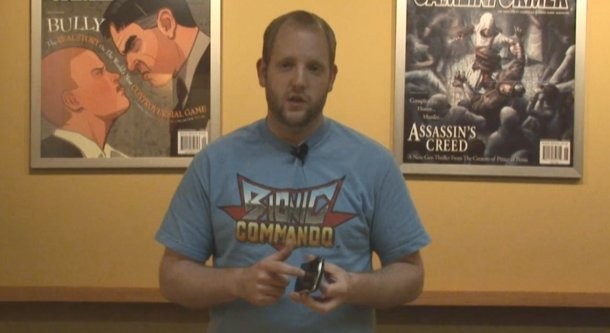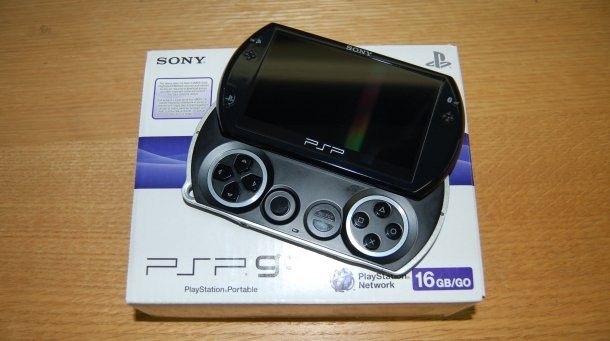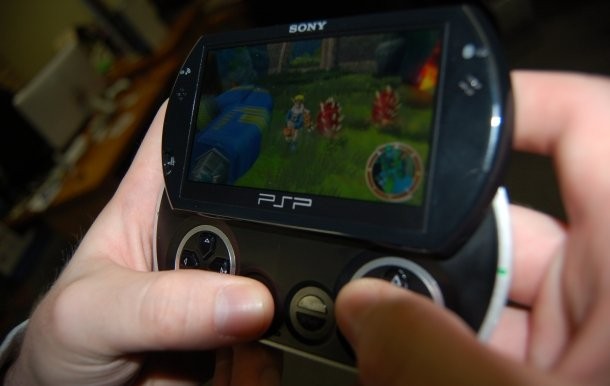Please support Game Informer. Print magazine subscriptions are less than $2 per issue
Hardware Review: PSPgo Hands-On With Video

I
was very excited when the PSPgo arrived in the office. I had been
covering the handheld's exposure over the months, and was intrigued by
the prospect of a digital-only device. My enthusiasm persisted as I
contemplated tearing into the shiny box, but held off for the sake of
an epic unboxing video. After freeing the thing from its packaging, I
spent an entire day messing around with it. I downloaded games, videos,
pictures, and played the gamut of titles on the sexy handheld. Were my
expectations met as I explored the market's newest gaming device, or is
the PSPgo a handicapped device with a pretty new coat of paint?
Our
inaugural video review. The PSPgo is first up to bat. I apologize in
advance that my mug is the first face you have to see in full motion on
the new site, feel free to squirm in your chair as you watch my
awkwardness.
Video:
[View:http://media1.gameinformer.com/media/video/2009/Gear/pspreview/pspreview.smil:610:343]
A New Look
First
and most obviously, the PSP has gone under the knife and had some
liposuction. The device is sleeker, sexier, and more streamlined than
any iteration before it. A smaller, sliding screen lends to its compact
portability, conveniently hiding the buttons underneath. The buttons
themselves have been reduced, recessed, and rearranged. You'll now find
the analog nub to the right of the d-pad, with other buttons such as
brightness and volume being tucked out of the way on the top of the
system.
Sony's
penchant for black glossiness continues with the 'go,' successfully
resulting in a paint job I refer to as "midnight thumbprint." The
position of the speakers has also shifted to the front of the system,
so no more accidental mutes with your palms. The headphone and USB
inputs have moved closer to the very bottom of the system, meaning
cords will no longer interfere with your grip.
Gameplay
When
I actually got down to playing games, the PSPgo initially felt natural
in my hands. I chose to assess the system's ergonomics by playing Metal
Gear Solid: Peace Walker, which utilizes every button on the system. In
Peace Walker, you use the analog nub to move, the face buttons to
adjust the camera/aim, and the shoulder buttons to ready/fire your
weapon. Each mechanic works well, but when you're attempting to move,
aim, and shoot simultaneously things start to get slippery. Reaching my
thumb down to the analog nub while holding down the left trigger was
difficult, and with the back of the flipped up screen crowded my
finger. It's an issue that dedicated players will easily get used to,
but it's present.
Playing
any game for too long also leads to notable hand cramp-age. The buttons
are all squished closer together on the system, so your hands take on a
claw-like formation. This can be remedied by repositioning your hands
or simply taking a break, but that can be frustrating when you just
want to focus on the game. No gamer should ever be taken out of the
game by distracting, uncomfortable controls. The PSPgo's button layout
works better with simplistic control schemes.
Digital-Downloads
I
didn't get too far trying to jam a UMD into the PSPgo, so I used the
three download methods instead. The most simple and obvious method is
downloading via a WiFi connection straight to the PSPgo. You can browse
PSN on the fly and download games and demos at will. I pulled down a
Final Fantasy: Dissidia demo in about seven minutes with a so-so
internet connection. This is undoubtedly the winning feature of the
PSPgo.
I also downloaded a PSP game on the PlayStation 3. If
you've ever copied games from the PS3 to a PSP before, this is
ultimately the same thing. After you download the game from PSN to your
PS3's harddrive, the transfer the PSP is very quick and simple. The PS3
will be a valuable tool for sorting your PSP game library when it
exceeds the storage capacity.
PC
users can use Media Go to download and manage their digital game
collection. The layout of the user-friendly software is similar to
iTunes. If you've never used the program before, expect a few updates
and computer restarts before you're ready to fire up your PSPgo with
it. If you're a Mac user, however, you're out of luck.
The
process of moving videos, pictures, and music from your PC to the go
has been simplified. Whenever you plug your PSPgo into the computer, it
automatically enters USB Mode, letting you get right into file
management. Common image and music files work just fine, but videos
will have to be converted into MP4s before you can watch them on the
handheld. There's a plethora of easy-to-use video converters online, so
watching movies on the fly is a few progress bars away.
The
games populating the downloadable space vary right now. You can
download incredible PSP games like God of War: Chains of Olympus,
Persona, or Patapon 2, but the rest of the PSP catalog leaves a sense
of wanting. The PSP Minis space is populated by seven lonely games,
with Tetris standing out as a decent-looking download. The PSone
Classics do a good job of filling out the gaps, with Final Fantasy VII,
Metal Gear Solid, Resident Evil, and Castlevania: Symphony of the Night
threatening your digital wallet. You can even snag the original Silent
Hill for $5.99. It's not a stellar enough lineup to justify immediately
throwing down for a brand new system, however. Especially when you take
into consideration that Sony has stated that getting their whole
backlog of PSP games available digitally may not be possible.
Impressions
The
PSPgo is an undeniably better looking version of Sony's handheld, but
how far does that take it?. Despite the cute redesign, the PSPgo feels
like it's lacking features. Though it's cool to slide the screen down
and just watch videos, you're still dealing with a significantly
smaller screen size. And how long will it be before the slide mechanism
starts to loosen? The buttons are so recessed that sometimes it doesn't
feel like you're pressing anything. Having to reach your thumb towards
the middle of the PSPgo puts an awkward torque on how you're holding
it, causing the system to twist slightly in your grasp. As stated
before, playing games feels fine in bursts, but the minimalist control
layout eliminates marathon gaming.
The
UMD drive is gone, but whether or not that's a positive is debatable.
The hassle of having to manage physical media has been replaced with
cords and progress bars. Also, the out-of-the-box storage space is
actually 14GB, not 16. This means that after your download all your
favorite games, you're going to be busy deleting demos and transferring
files instead of juggling disks. That's where personal preference comes
in. Which scenario sounds more annoying to you?
The PSPgo has
undergone a lot of changes, but there are some unfortunate holdovers
from the system's past. The battery life hasn't increased at all,
you're still looking at 3-6 hours (about an hour less if you're
watching videos). This issue has been remedied slightly by knocking
down charge time by 40 minutes, and you can charge the 'go' via USB in
four hours. Using WiFi drains the battery even further, which is
disappointing considering downloading games directly to the system is
the main draw.
All
these issues are amplified by the fact that the console is releasing at
$249.99. This was the asking price for a PSP at its launch almost five
years ago. Even with the bevy of awesome PSone games and handful of
good PSP titles, the pricetag is a unreasonable considering you still
have to purchase all these games. Justification for the purchase of a
PSPgo will become easier if Sony really pushes the PSone backlog hard
and works on securing digital rights for more old PSP games.
It's
tough to say who the PSPgo is aimed at. Diehard PSP fans that love the
digital game library already own a PSP, and are only a memory stick
away from enjoying digital downloads via the PS3 if they haven't
already. For those who've yet to purchase a PSP, the lacking launch
library makes the handheld difficult to recommend.
Only hardcore PSP fans with a digital fetish and some spare change need apply.










